Council of Five Elders
The Council of Five Elders (Japanese: 五大老 Go-Tairō), was a group of five powerful feudal lords (Japanese: 大名 Daimyō) formed in 1598 by the Regent (Japanese: 太閤 Taikō) Toyotomi Hideyoshi, shortly before his death the same year.[1] While Hideyoshi was on his deathbed, his son, Toyotomi Hideyori, was still only 5 years old and as such Hideyoshi needed to create the council in order to ensure his heir would be able to succeed him after coming of age. They also acted as advisers for the Five Commissioners (Japanese: 五奉行 Go-Bugyō), which had also been established by Hideyoshi to govern Kyoto and the surrounding areas.[2]
| History of Japan |
|---|
.jpg) |
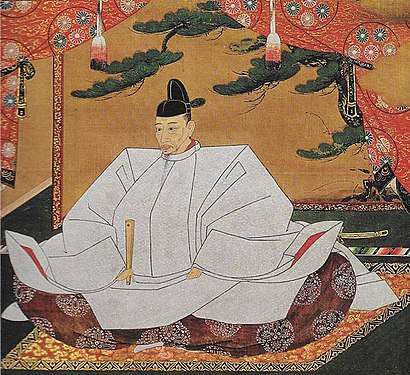
Creation of the Council
Leading up to the creation of the council
Hideyoshi had been slowly changing in demeanor as the invasions of Korea (in attempt to conquer both Korea and China) were failing. Hideyoshi himself had not joined the Korean Campaigns and assigned vassals in his command to head the campaign.[3] He sent his final force of 140,000 to Korea in 1597, but the efforts were fruitless.[4]
Hideyoshi's execution of family members were also one of the reasons for questioning his sanity during this period.[5] Before the birth of his son Hideyori, he had adopted his nephew, Toyotomi Hidetsugu, to be his heir in 1591 because Hidetsugu had helped Hideyoshi in his campaigns.[6] Once Hideyori was born, he ordered Toyotomi Hidetsugu to commit ritual suicide on Mount Kōya, this causing Hideyoshi's only possible heir to be his infant son Hideyori. The people closest to Hidetsugu, such as his family and retainers, were also put to death.[7]
In 1595 Toyotomi Hideyoshi officially announced five laws and ordinances (Japanese: 御定五ヶ条 Onkite Gokajō) to maintain the stability of the regime and overcome the upheaval of politics after the removal of Hidetsugu.
On the "fifteenth day of the seventh month", the senior daimyō under order gathered at Maeda Toshiie's residence in Fushimi to renew their pledge of loyalty to Hideyori.[8] On the "fifth day of the eighth month", Hideyoshi issued an order to the Elders stating that children of various generals shall go to Osaka Castle, once Hideyori has moved there.[9]
Hideyoshi's health started to degenerate after falling ill in the later half of 1598.[7] Realizing he would need to find a way to ensure the installation of his son as heir following his death, he called out to certain trusted daimyō to grant his final request:[10]
"Until Hideyori reaches adulthood, I am asking for the help of the people whose names are listed in this document. This is the only request I want to make."
Fifth day, Eighth month
To: Ieyasu
Chikuzen
Terumoto
Kagekatsu
Hideie
— Toyotomi Hideyoshi, 101 Letters of Hideyoshi (Boscaro 1975, p. 77)
There are also accounts that when Hideyoshi called upon Ieyasu to become a regent, he asked him to decide if Hideyori is fit to rule when he reaches a ripe age and that Ieyasu rejected this request.[11][12]
Choosing the council
The members of the council were all daimyō chosen due to their relation to the taikō and the amount of power they held in the country. Hideyoshi chose powerful daimyō to prevent authority being concentrated on a single daimyō. Maeda Toshiie and Ukita Hideie were chosen due to their closeness with Hideyoshi as Maeda Toshiie was Hideyoshi's friend who had also served Oda Nobunaga. Maeda Toshiie was also chosen due to the respect he had from the Toyotomi family and Hideyoshi wanted to prevent Ieyasu from holding absolute power among the Five Elders. Ukita Hideie had been adopted under the name of Yuushi (Japanese:猶子) by Hideyoshi and his closeness with Hideyoshi also led him to be appointed as a member of the five elders.[7][13] These daimyō had also all served under Hideyoshi for many years in his house administration.[14]
Even before the creation of the council, Hideyoshi treated the five differently from other daimyō. One of the reason was the absence of a Toritsugi (Japanese: 取次). Toritsugi acted as mediators that went between the daimyō to help with the communication of orders. This allowed each daimyō to talk directly to Hideyoshi, and it also meant that Hideyoshi would not intervene in the business of the daimyō in ruling their own domain. For the Shimazu clan, Ishida Mitsunari was appointed as the toritsugi, which also meant that Mitsunari and/or Toyotomi had power to intervene in Shimazu’s domain. Hideyoshi expected the daimyō under his control to govern their lands and serve military services.
The larger the domains of the daimyō were, the more experienced those daimyō were at governing their lands and as such, Hideyoshi treated them differently compared to smaller daimyō which needed Hideyoshi to intervene in local governance. In the 1588 Sword Hunt Policy (Japanese:刀狩 katanagari), it is assumed that Hideyoshi only ordered to smaller class daimyō to enforce the policy. The larger daimyō followed even without orders, however Hideyoshi did not strictly expect them to enforce the policy. Initially the sword hunt was intended to confiscate weapons to restrict forces, ensuring that no one could take the country by force. Hideyoshi was able to rely on the large daimyō that were experienced and equipped with large military forces to be able to suppress the local powers even if they were to rebel. In this way, Hideyoshi’s treatment of the larger daimyō, Tokugawa, Maeda, Mori, and Uesugi, was exceptional.[15]
Subgroups related to the council
Hideyoshi also appointed the Five Commissioners (Japanese: Go-Bugyō) who were tasked to oversee the "basic business of the realm"; while the Elders were tasked to make sure that Hideyori would succeed Hideyoshi.[8] During this time the Five Commissioners were Asano Nagamasa, Mashita Nagamori, Ishida Mitsunari, Natsuka Masaie and Maeda Gen'i.
The Elders had assistants known as chūro (Japanese: 中老) who acted as mediators, the Five Elders and the Five Commissioners.[16] The chūro at this time were Nakamura Kazu-uji of Suruga, Ikoma Chikamasa of Takamatsu, and Horio Yoshiharu of Tottori.
Oath of Allegiance
On the "fifth day of the eighth month", 1598, the Commissioners and the Regents signed the following articles:
Article 1. That they should serve Hideyori with the same single-minded loyalty they had shown to Hideyoshi
Article 2. The rules of Hideyoshi's house shall not be altered. When in the administration of public affairs the Five Commissioners were unable to determine on a course of action they were to consult their master (Hideyori) through Ieyasu and Toshiie, or necessary if taking action, the Emperor has to be consulted.
Article 3. There were to be no factions among them. Personal considerations and partiality of every kind were to be excluded from their counsel.
Article 4. The Five Commissioners, or overseers, must strive to work together in the administration of public affairs, suppressing all petty jealousies and differences.
Article 5. In settling matters the opinion of the majority was usually to be followed. But at the same time if the opinion of the minority showed no signs of being dictated by any personal interests, it should be duly considered. If it should happen that only a few of the overseers were present when some question was settled, the absentees had no right to object unless it was quite evident that the private interests of the Commissioners present at the meeting prejudiced their minds in a wrong direction. In that case another meeting might be called.
Article 6. It goes without saying that all accounts had to be kept in a manner that was above suspicion. There were to be no irregularities and no pressing of personal interests in this line.
Article 7. Whatever Hideyoshi desired to be kept secret, whether it were connected with his private life or with the Government, must on no account be allowed to leak out
Article 8. If any of the Commissioners or their followers found that unconsciously they had acted contrary to the orders given to them, they were at once to report the same to their superior officers, who would then deal leniently with them.[17]
Hideyoshi used a talisman (Japanese: 護符 Gofu) called Kumano-goufu (Japanese: 熊野牛王府) from Kumano Shrine when making an oath with daimyō, and it is said that when Hideyoshi's death was near, he made the five elders to write vows to remain faithful to him after his death.[18] This vow is known in Japanese as Kishomon (Japanese: 起證文).[12]
Origin of the name "Go-Tairō"
After the death of Hideyoshi, the five commissioners, including Ishida Mitsunari referred to Ieyasu and the other elders as Go-bugyoshu (Japanese:御奉行衆) and referred to the five commissioners as Toshiyoridomo (Japanese:年寄共) on Kishomon. He purposely used the term Go-bugyoshu to remind the elders that their job is to support Hideyori with their lives.[19] On the other hand, Shimazu Yoshihisa referred to the five elders as Go-rojushu (Japanese: 御老中衆) and Kato Kiyomasa called them the Nihon-Gotoshiyorishu (Japanese: 日本御年寄衆). They both called the five commissioners Go-bugyoshu (Japanese: 御奉行衆).[20] People were calling them differently depending on their relationship with the five elders and the five commissioners, but there is no document that gives evidence that the Five Elders were actually called as Go-Tairo. The word Tairo (Japanese: 大老) was the name of the highest position that was temporarily a higher position than Roju (Japanese: 老中), under the Tokugawa Shogunate. It is believed that the Five Elders were referred to as the Go-Tairo after the title of Tairo was created in the Edo Period.[21]
The Five Elders
(In Japanese names, the family name is written first)
Tokugawa Ieyasu
Tokugawa Ieyasu (Japanese: 徳川 家康) was the founder and first shōgun of the Tokugawa shogunate of Japan, which effectively ruled Japan from the Battle of Sekigahara in 1600 until the Meiji Restoration in 1868. Among the Five Elders, Ieyasu held the most power measured in koku.[8] He was also entrusted by Hideyoshi with the order of Soufujirei (Japanese: 惣無事令) to take control of Kanto and Okuryogoku (Mutsu Province and Dewa Province) in 1587.[22] After the Hidetsugu Incident (Japanese:秀次事件 Hidetsugu Jiken) in 1597, Ieyasu was appointed to act as Regent temporarily until Hideyori reached 15 years of age and requested him to reside in Fushimi.[12] Before the establishment of the Council, Hideyoshi awarded the province of the Hojo to Ieyasu after the successful Odawara campaigns in the Kanto region.[23] This action demonstrated the power that Hideyoshi had over Ieyasu.[23]
Ukita Hideie
Ukita Hideie (Japanese: 宇喜多 秀家) was the daimyō of Bizen and Mimasaka Provinces (modern Okayama Prefecture). He was a military commander and feudal lord during Azuchi-Momoyama period. Also referred to as Hachirō (八郎). He was banished to Hachijō Island after the Battle of Sekigahara. At the age of 26, Ukita was elected to be one of the five elders when he returned from Imjin war, also known as the Japanese invasions of Korea. (Japanese: 慶弔の役 keicho no eki). While he was an elder, he was also serving as a daimyō during the Warring States period (Japanese: 戦国時代 Sengoku Jidai).
Maeda Toshiie
Maeda Toshiie (Japanese: 前田 利家) was one of the leading generals of Oda Nobunaga following the Sengoku period of the 16th century extending to the Azuchi–Momoyama period. Referred to as Chikuzen in the letters by Hideyoshi.[24] He became one of the Five Elders at the age of 53. Hideyoshi entrusted the province of Kaga and Etchū to Toshiie after taking the province from the daimyō Sassa Narimasa. While he was an elder, he also had a position as senior second rank (Japanese: 権大納言 Gon-Dainagon) and had the authority to pass his opinions on to the national government. After the death of Maeda Toshiie, his son, Maeda Toshinaga was to succeed him as a member of the Five Elders.
Uesugi Kagekatsu
Uesugi Kagekatsu (Japanese: 上杉 景勝) was a Japanese samurai and daimyō during the Sengoku and Edo periods. He was the primary lord of the feudal domain of Yonesawa. He was elected to be a part of five elders at the age of 43. Since the Battle of Shizugatake in 1583, he had cooperated with Hideyoshi by aiding him during battles, and he was one of the earliest daimyō to render homage to Hideyoshi.[25] Hideyoshi had made alliances with Uesugi because he had the potential power to attack Ieyasu from the Echigo province in the north.[6]
Mōri Terumoto
Mōri Terumoto (Japanese: 毛利 輝元) was a Japanese daimyō during the Azuchi-Momoyama period and the Edo period. He was a descendant of the feudal lord of the Choshu domain. He became one of the Five Elders at the age of 46. Terumoto fought against Hideyoshi before the latter's rise to power, but lacked enough supporters. Realizing that Hideyoshi would be the next leader of the country, he began to build trust by sending gifts to celebrate Hideyoshi's victory at the Battle of Shizugatake and helping him in the Kyushu Campaign in 1587.[26]
He was allied with Ishida Mitsunari at the Battle of Sekigahara and acted as the head general of the Western Army.
Kobayakawa Takakage
Kobayakawa Takakage (Japanese: 小早川 隆景) was a samurai and daimyō (feudal lord) during the Sengoku period and Azuchi–Momoyama period. At first he fought against Hideyoshi as he was the one holding the power in the Mōri family, but after the Battle of Shizugatake, he decided to submit to Hideyoshi.[27] Under Hideyoshi's rule, he was assigned to be in charge of Chikuzen province, which is modern day Fukuoka.[28] Takakage handed over rule of the family to Hidetoshi (Hideaki) and retired, moved to Mihara.[29] Takakage refurbished Najima Castle (Japanese: 名島城 Najima Jō) and made it his own residence. Kobayakawa died on June 12, 1597 at the age of 65. Due to the death of Kobayakawa in 1597, he is often excluded from the list of the Five Elders or referred as the 6th Elder.[30] After his death his nephew, Mōri Terumoto, took his place on the council of Five Elders.
- Tokugawa Ieyasu
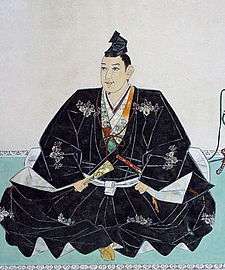 Ukita Hideie
Ukita Hideie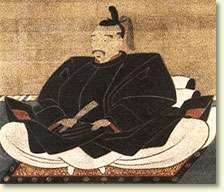 Maeda Toshiie
Maeda Toshiie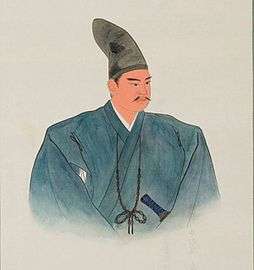 Uesugi Kagekatsu
Uesugi Kagekatsu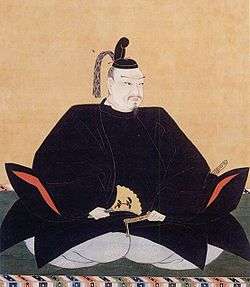 Mōri Terumoto
Mōri Terumoto.jpg) Kobayakawa Takakage
Kobayakawa Takakage
Roles of the Council Members
Raising Hideyoshi's heir
Hideyoshi had given ownership of Osaka castle to his son Hideyori in 1594, Hideyori was just 1 year old at the time.[7] Maeda Toshiie was given the order to raise Hideyori in Osaka Castle until he came of age to take his place as Hideyoshi's successor.[31] Tokugawa Ieyasu was also charged with the role of guardian of Hideyori, as well as to see to Hideyori being appointed to the role of Regent.[32] Ukita Hideie was to be counted on as a loyal member of Hideyori's service.[33]
Attending to political business
Ieyasu was appointed by Hideyoshi to act as Regent (Japanese:摂政 Sesshō) until Hideyori reached maturity and could take his place as leader.[12] Uesugi Kagekatsu and Mōri Terumoto were to informed and consulted on all political matters as advisers. The Elders were to deal with the administering of punishment to any person who broke the law. All monetary transactions were to be supervised by the Elders, and the elders were tasked with to setting up an account for Hideyori when he came of age.[34]
Withdrawal from Korea
After Hideyoshi's death the Council of Five Elders issued an order for the Japanese army at the Korean Peninsula to return. The Council feared disorder among Hideyoshi’s troops in Korea if they were to be told of his death and so, his death was not told to the armies in order to preserve their morale. After the withdrawal of Japanese armies which followed a military stalemate, the final peace negotiations to mark the end of war continued for several years.[35]
Other roles
Ieyasu and Toshiie were to clear up any difficulties in administration encountered by the Five Commissioners, further acting as advisers or mediators in administration matters.[12] The sons of both Tokugawa Ieyasu and Maeda Toshiie (Tokugawa Iesada and Maeda Toshinaga respectively) were to assist their fathers with work related to the Five Elders, with plan of the latter being appointed as an Elder in the future.[36]
Changes to Oath of Allegiance document
Tokugawa Ieyasu made some changes to Article 2 of the Oath of Allegiance document that no rules shall be amended, and that decisions were to be made by the majority in all cases.[12]
On the Article 6 of the Allegiance Document Ieyasu added the following statements: "No questions concerning landed estate will be dealt with during the minority of Hideyori. No petitions made to him will be sent in; neither will Ieyasu himself ask for any changes to be made in the matter of land-ownership nor will he accept any gifts of land from Hideyori during his minority."[12]
Maeda Toshiie added the following words "When Hideyori shall have reached his majority, certain representations shall be made to him by the Five Commissioners and by Ieyasu in reference to the bestowal of land on those whose services deserve reward and in reference to the confiscation of land in the case of those who have acted unworthily."[12]
Power balance between the council
The power balance between the council depended on the position each members held and the amount of koku they held. Ieyasu was entitled with the position of inner minister (Japanese: 内大臣 Naidaijin) in the fifth month of 1596.[11] Maeda was acting as counselor of the first rank (Japanese: 大納言 Dainagon)and the other three were counselors of the second rank (Japanese: 中納言 Chunagon).[37] Ieyasu was in the highest position among the members and his ownership of a great amount of koku allowed him to secure his position among other Elders. In general, 10,000 koku was believed to be equivalent to having 250 soldiers in one's control, so the amount of Koku (Japanese: 石) didn't only represent the income each daimyō has, but show how much military power they held.[38] Hideyoshi himself owned approximately 2,000,000 koku, which is not including the lands held by his most trusted vassals. Ieyasu was also known as a powerful military commander, and Hideyoshi's fear of Ieyasu and riots in favor of Ieyasu also led him to appoint Ieyasu as a member of the Council of Five Elders.[13]
The amount of potential income, measured in koku, that each council member held (one koku = 4.96 bushels or 278.3 liters of rice):[4]
- Tokugawa Ieyasu: 2,400,000 koku
- Maeda Toshiie: 830,000 koku
- Ukita Hideie: 570,000 koku
- Uesugi Kagekatsu: 1,200,000 koku
- Mori Terumoto: 1,120,000 koku
Tokugawa hegemony
Ieyasu engaged his sons and daughters into political marriages which became a cause of disagreement between the Elders and Commissioners.[11] Ieyasu married his son Tadateru to the Date Masamune's daughter Irohahime. The cause for disagreement in these matters were due to statements in ”The wall writings of Osaka Castle" (Japanese: 大阪城中壁書 Osakajochu-kabegaki) of 1595 that marriages would need the consultation of both Elders and Commissioners.[39] The Commisoners called for Ieyasu's resignation on the grounds of these marriages.[40] One of the retainers, Ishida Mitsunari, complained about this matter to Maeda Toshiie. Ieyasu insisted that it was not a big matter; and this issue was resolved by Horio Yoshiharu, who happened to be a friend of Ieyasu.[40]
Rise of conflict
After the death of Hideyoshi, friction generated between the council members. Two factions formed, the Bunchiha (Japanese: 文治派) (those who wished for a state governed by a specialized civil service) and the Bundanha (Japanese: 武断派) (those in favor of a strong military authority), of these two factions Tokugawa Ieyasu was part of the bundanha. One year after Maeda Toshiie died, Ieyasu saw his chance to take control. The death of Maeda Toshiie in 1599 made Ieyasu the most experienced of the Five Elders. Finally, due to the fact that Uesugi Kagekatsu had been illegally constructing and restoring forts, Ieyasu was able to justify going to battle which led to the Battle of Sekigahara in 1600.[31] Following the battle, in 1603, Ieyasu became Shōgun while Hideyori was declared naidaijin. Ieyasu sent his granddaughter, Senhime to Osaka to marry Hideyori in order to stabilize the relationship between the two families.[12]
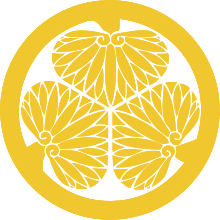
Tokugawa Ieyasu rose to power while originally working in the name of Toyotomi Hideyori. Eventually, after Ieyasu's power seemed to be threatened by Hideyori a long series of plots both against Ieyasu and Hideyori occurred followed by the multiple battles of the Siege of Osaka (1614-1615). Tokugawa Ieyasu reigned victorious against the Toyotomi clan, eliminating them completely, thus cementing his place as ruler of Japan.[41]
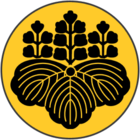
Following the Tokugawa victory at the Siege of Osaka in 1615, Ieyasu was not satisfied with destruction of Hideyori alone, but in order to make sure the Toyotomi clan would not be able to return to power in the future, he had as many as possible of the Toyotomi family killed, or in the case of Hideyori's daughter, placed in a nunnery.[41] Ieyasu had Hideyori’s son Kunimatsu, who was 8 years old at the time, killed at the Rokujō riverbed (Rokujō-Gawara) in Kyoto.[12]
In popular culture
The Council of Five Elders can also be seen in Japanese historical drama, Taiga Drama, which is broadcast by NHK. This topic is briefly mentioned in Gunshi Kanbei and Tenchijin, and more in detail in Sanadamaru.[42][43] In the 31st episode of Sanadamaru, a brief explanation of why the Council of Five Elders didn't work out as Hideyoshi expected is explained and we can also see that Elders were referred as Otonashu(Japanese: 老衆). The drama also shows that early death of Maeda Toshiie had led to Ieyasu gaining more power, and Ishida Mitsunari's lack of popularity among the Toyotomi family caused a lot people to support Ieyasu during the Battle of Sekigahara.[13]
See also
- Yodo-dono
- Azuchi-Momoyama Period
- Toyotomi Hideyoshi
- Toyotomi Hideyori
- Battle of Sekigahara
- Five Commissioners
- Tokugawa Shogunate
- Edo Period
References
- Mikiso, Hane (2014-11-11). Premodern Japan : a historical survey. Perez, Louis G. (Second ed.). Boulder, CO. p. 180. ISBN 9780813349701. OCLC 895428280.
- "五大老の序列や五奉行との違いなどについて解説!". 歴史をわかりやすく解説!ヒストリーランド (in Japanese). 2016-08-04. Retrieved 2018-06-10.
- 1883-1965., Sansom, George Bailey, Sir (1961). A history of Japan, 1334-1615. Stanford, Calif.: Stanford Univ. Press. p. 363. ISBN 0804705259. OCLC 16859819.CS1 maint: numeric names: authors list (link)
- Conrad., Schirokauer (2013). A brief history of Japanese civilization. Lurie, David Barnett., Gay, Suzanne Marie. (4th ed.). Boston, MA: Wadsworth, Cengage Learning. ISBN 978-0495913252. OCLC 772592935.
- 1947-, Berry, Mary Elizabeth (1982). Hideyoshi. Cambridge, Mass.: Harvard University Press. p. 222. ISBN 0674390253. OCLC 8195691.CS1 maint: numeric names: authors list (link)
- R., Turnbull, Stephen (2010). Toyotomi Hideyoshi. Rava, Giuseppe, 1963-. Oxford: Osprey. ISBN 9781846039614. OCLC 650342003.
- Sadler, A.L. (2009). Shogun: The Life of Tokugawa Ieyasu. Tuttle. ISBN 9784805310427.
- Berry, Mary Elizabeth (1982). Hideyoshi. Cambridge, Mass.: Harvard University Press. pp. 139, 234. ISBN 0674390253. OCLC 8195691.
- 1947-, Berry, Mary Elizabeth (1982). Hideyoshi. Cambridge, Mass.: Harvard University Press. p. 235. ISBN 0674390253. OCLC 8195691.CS1 maint: numeric names: authors list (link)
- Boscaro, Adriana (1975). 101 Letters of Hideyoshi. Tokyo: Sophia University. p. 77.
- Sadler, Arthur Lindsay (1937). The maker of modern Japan : the life of Tokugawa Ieyasu. London: Unwin Brothers Ltd. pp. 182, 185.
- 1846-1913., Dening, Walter (1971). The life of Toyotomi Hideyoshi. New York: AMS Press. pp. 270. ISBN 040402078X. OCLC 1392654.CS1 maint: numeric names: authors list (link)
- "第31回 あえなく崩れた五大老五奉行制、豊臣政権崩壊は秀吉の誤算に始まる - 真田丸の補足解説". www.taigafan.com (in Japanese). Retrieved 2018-06-10.
- Warrior rule in Japan. Jansen, Marius B. New York, NY: Cambridge University Press. 1995. p. 161. ISBN 0521482399. OCLC 31515317.CS1 maint: others (link)
- Kesareta Hideyoshi no shinjitsu : Tokugawa shikan o koete. Yamamoto, Hirofumi, 1957-, Hori, Shin, 1961-, Sone, Yūji, 1954-, 山本博文, 1957-, 堀新, 1961-, 曽根勇二, 1954-. Tōkyō: Kashiwa Shobō. 2011. ISBN 9784760139941. OCLC 726819437.CS1 maint: others (link)
- 1883-1965., Sansom, George Bailey, Sir (1961). A history of Japan, 1334-1615. Stanford, Calif.: Stanford Univ. Press. pp. 336–337. ISBN 0804705259. OCLC 16859819.CS1 maint: numeric names: authors list (link)
- 1846-1913., Dening, Walter (1971). The life of Toyotomi Hideyoshi. New York: AMS Press. pp. 269. ISBN 040402078X. OCLC 1392654.CS1 maint: numeric names: authors list (link)
- "特別授与品 - 熊野速玉大社公式サイト|和歌山県新宮市鎮座 根本熊野大権現 世界遺産". kumanohayatama.jp (in Japanese). Retrieved 2018-06-17.
- 武家事紀. 第三十一. Check date values in:
|year=(help) - 島津家文書. 大日本史料.
- 脇田, 修 (1977). 近世封権制成立史論 織豊政権の分析II. 東京大学出版会. ISBN 978-4130200462.
- "第18回 1586年の豊臣秀吉、統一目前で勢いは最高潮 - 真田丸の補足解説". www.taigafan.com (in Japanese). Retrieved 2018-06-16.
- R., Turnbull, Stephen (2012). Tokugawa Ieyasu : leadership, strategy, conflict. Rava, Giuseppe, 1963-. Oxford: Osprey Pub. ISBN 9781780964447. OCLC 803923982.
- Boscario, Adriana (1975). 101 Letters of Hideyoshi. Tokyo: Sophia University. p. 99.
- "上杉景勝とは~豪毅果断・潔白謹厳で笑わない戦国武将". 戦国武将列伝Ω (in Japanese). 2014-10-01. Retrieved 2018-06-17.
- "毛利輝元とは【かろうじて毛利家をつないだ戦国大名】". 戦国武将列伝Ω (in Japanese). 2015-09-09. Retrieved 2018-06-17.
- "小早川隆景【詳細版】~毛利家大きく支えた智将". 戦国武将列伝Ω (in Japanese). 2014-03-09. Retrieved 2018-06-17.
- 映像授業 Try IT(トライイット) (2016-04-15), 【日本史】 近世11 織豊政権8 豊臣秀吉5 (11分), retrieved 2018-06-17
- 渡辺, 世祐 (1980). 小早川隆景. マツノ書店.
- "【 幻のシックスマン?】 豊臣政権「五大老」、実は六人目にはあの智将がいた" (in Japanese). Retrieved 2018-06-10.
- 1949-, Vande Walle, Willy (Willy F.) (2014). Een geschiedenis van Japan : van samurai tot soft power (Derde, herwerkte uitgave ed.). Leuven: Acco. p. 159. ISBN 9789462920392. OCLC 905221450.CS1 maint: numeric names: authors list (link)
- 1883-1965., Sansom, George Bailey, Sir (1961). A history of Japan, 1334-1615. Stanford, Calif.: Stanford Univ. Press. p. 368. ISBN 0804705259. OCLC 16859819.CS1 maint: numeric names: authors list (link)
- 1883-1965., Sansom, George Bailey, Sir (1961). A history of Japan, 1334-1615. Stanford, Calif.: Stanford Univ. Press. p. 368. ISBN 0804705259. OCLC 16859819.CS1 maint: numeric names: authors list (link)
- 1883-1965., Sansom, George Bailey, Sir (1961). A history of Japan, 1334-1615. Stanford, Calif.: Stanford Univ. Press. p. 368. ISBN 0804705259. OCLC 16859819.CS1 maint: numeric names: authors list (link)
- Turnbull, Stephen. Samurai Invasions of Korea 1592–1598, p. 85
- 1883-1965., Sansom, George Bailey, Sir (1961). A history of Japan, 1334-1615. Stanford, Calif.: Stanford Univ. Press. p. 368. ISBN 0804705259. OCLC 16859819.CS1 maint: numeric names: authors list (link)
- "五大老筆頭 徳川家康は他の大老たちを凌駕するだけの力を持っていた!?". ひすとりびあ (in Japanese). 2016-01-17. Retrieved 2018-06-10.
- "戦国大名の軍事力はどれくらい? - 日本史が好きになる?歴史ブログ". 日本史が好きになる?歴史ブログ (in Japanese). 2017-02-02. Archived from the original on 2018-07-16. Retrieved 2018-06-17.
- 1947-, Berry, Mary Elizabeth (1982). Hideyoshi. Cambridge, Mass.: Harvard University Press. p. 144. ISBN 0674390253. OCLC 8195691.CS1 maint: numeric names: authors list (link)
- Sadler, A.L. (1937). The Maker of Modern Japan: The Life of Tokugawa Ieyasu. Great Britain: Unwin Brothers Ltd. p. 186.
- D., Totman, Conrad (1995). Early modern Japan. Berkeley: University of California Press. pp. 53. ISBN 9780520917262. OCLC 47007934.
- 日本放送協会. "大河ドラマ「軍師官兵衛」|NHKドラマ". NHKドラマ (in Japanese). Retrieved 2018-06-15.
- "人物紹介 | 大河ドラマ「天地人」 | チャンネル銀河". www.ch-ginga.jp. Retrieved 2018-06-15.